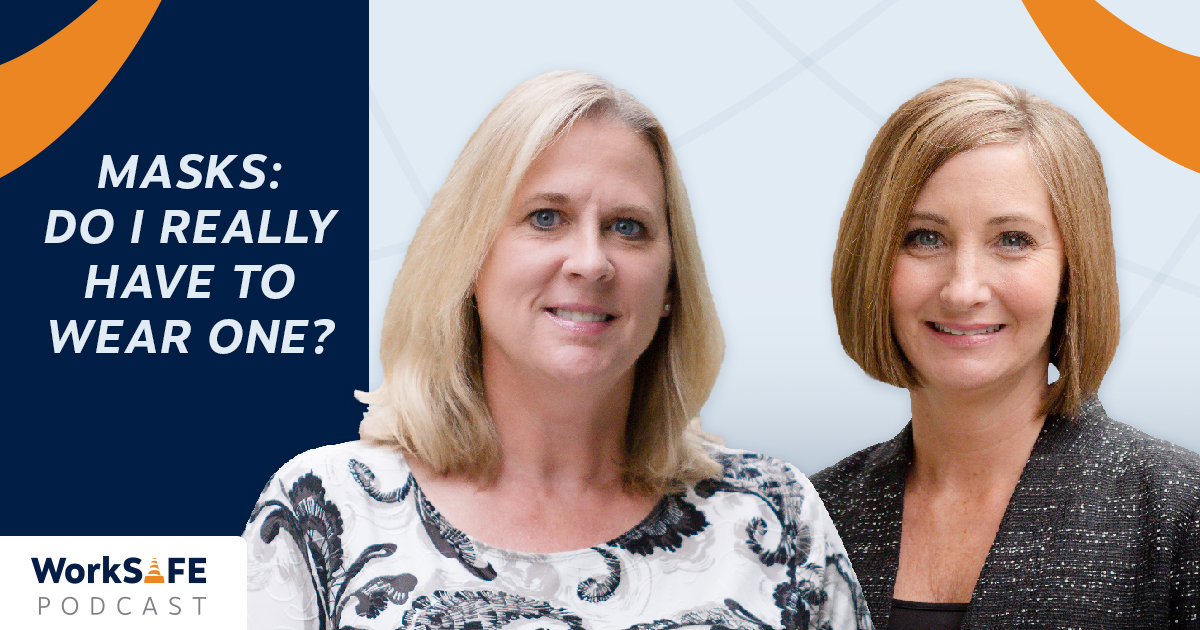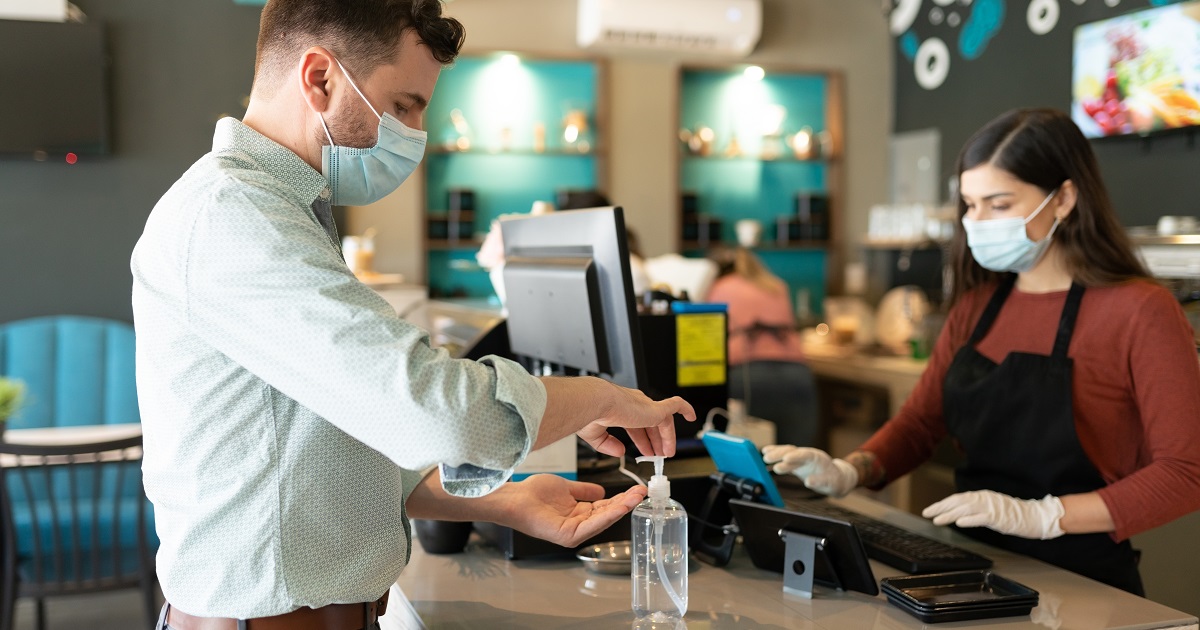For Media Inquiries
Contact Revee White, Director of Marketing and Communications at rwhite1@mem-ins.com or 573.499.4190.
The COVID-19 pandemic has caused major changes to the workplace. Business owners want to keep their employees and customers safe. But how can they do that? Wearing masks at work is one of many recommendations. In some industries, personal protective equipment (PPE), including masks, must be used all the time. Other industries have never used masks before. As a result, they may have a hard time trying to return to work safely. Understanding how masks help and when to wear them can be a challenge.
On this episode of the WorkSAFE podcast, we are joined by Rhonda Kauffman. She is a Safety and Risk Services Specialist at Missouri Employers Mutual. Kauffman has over 20 years of experience in occupational safety and industrial hygiene. She provides assistance and training for employers who want to bring health and safety programs to their workplaces.

First, we’ll cover common types of masks. Then, we’ll talk about different safety measures that can be used to prevent the spread of COVID-19. Finally, we’ll talk about how to introduce masks in your workplace.
Listen to this episode on the WorkSAFE Podcast, or read the show notes below.
The basics of masks: common types of face coverings
To reduce the spread of COVID-19, public health organizations have recommended that people cover their faces. Some people use a scarf or bandanna. Others use a paper mask. Employees can cover their faces in different ways. But not all masks are considered to be PPE. Kauffman spoke about the common types of masks. Some are more effective than others.
- Cloth masks. These masks help protect against dust and other airborne particles. They can also be washed and used again. However, these masks are often not certified by a regulatory agency. The Occupational Health and Safety Association (OSHA) does not consider cloth masks to be protective equipment.
- Surgical masks. These masks are approved by the US Food and Drug Administration (FDA). They also include NIOSH-certified N95 respirator masks. They protect against splashes and sprays medical professionals encounter while on the job. While these masks are protective and meet OSHA criteria, they are not recommended for the general public. Surgical masks are the most useful for the medical industry.
Safety controls: 5 methods used to protect employees
Every industry has a different type of work environment. To keep employees safe, business owners need to consider a control plan. A control plan helps separate employees from on-the-job hazards. Kauffman identified the top five safety controls and how effective they are.
- Elimination. The most effective way to address a workplace hazard is to eliminate it. However, we have not yet been able to completely get rid of COVID-19.
- Substitution. This method allows employers to replace a hazardous product or item with one that is safer for employees. Since COVID-19 is a virus, substitution is not an option.
- Engineering controls. This method uses equipment or tools. These items physically separate employees from the hazard. In the case of COVID-19, this could mean bringing in additional air filters. Installing clear Plexiglass barriers can also separate employees from customers or coworkers.
- Administrative controls. This method focuses on changing employee behavior. Social distancing, or putting six feet between yourself and others, is an example of this. This could also mean working from home or staggering shifts. Hand-washing and hand sanitizing are important behaviors to practice. Choose sanitizing products carefully, as those with high alcohol content can be flammable or toxic to humans.
- Personal protective equipment. This is the least effective control method to try. Effective PPE is made of the right material, worn correctly, and fits the wearer. If you use PPE correctly, then it can be helpful. However, if you don’t, it offers much less protection than you think.
Employers should carefully consider what control methods will be the most effective for their workplace. Check reliable sources, such as those shared by OSHA and the Centers for Disease Control and Prevention (CDC). MEM also provides updated information and workplace resources as information becomes available.

Using a mask: protecting against airborne particles
Kauffman shared that larger particles found in the air are around 100 micrometers – or about the width of a human hair. The size of a particle is important. It determines how far it can travel in the air. The size also affects what material it might stick to or gather in. Particles carrying the coronavirus can travel around 5 feet in the air before settling by gravity. This usually happens when someone coughs or sneezes. In a typical office setting, this process only takes a few seconds. While masks can protect against these particles, social distancing can also be just as effective.
Smaller particles – around 10 micrometers – usually settle to the ground within 10-30 minutes. Masks are still effective against these smaller particles. A typical cloth mask may remove up to 50% of particles in this size group.
Even smaller particles, around 0.3 micrometers, are the hardest to get rid of. They can stay in the air for hours, depending on how much airflow the space has. As a result, cloth masks aren’t very effective in reducing the spread of particles this size. Kauffman says studies show that up to 20% might be removed by this type of mask.
The smallest particle size, around 0.05 micrometers, spread easily and stick to any surface. However, they are not believed to transport the virus.
Do’s and don’ts for selecting and wearing face coverings
Wearing a mask is part of a larger effort to protect yourself from COVID-19 or other harmful airborne hazards. For a mask to be effective, you must wear and handle it correctly.
Wearing a mask is part of a larger effort to protect yourself from COVID-19 or other harmful airborne hazards. For a mask to be effective, you must wear and handle it correctly. Tweet this. >
Mask handling
If you wear a cloth mask, then it is important to wash it often. When you take your mask off, assume that it has the virus on the outside of it. Wash your hands after removing or touching your mask. Make sure to wash your hands before putting on a clean one. Having multiple masks is helpful if you are often out in public.
Mask size
The size of the mask should be the right size for the wearer’s face – not too big or too small. For the best benefits, the mask should cover both the mouth and nose.
Mask wearers
There are people who believe they are not at risk of catching the virus. They prefer not to wear a mask. But they may still expose those at higher risk to the virus. It is possible to give the virus to a high-risk person living in the same household. Wearing a mask, along with practicing controls like social distancing and hand-washing, can help people protect those around them.

Masks at work
Even though OSHA and the CDC may recommend mask usage, employees could respond differently to a requirement to wear masks at work. For example, some may welcome the changes. Others may be unhappy about wearing a mask that wasn’t required before.
Educating employees on mask usage
Kauffman says that education can make a huge difference. Explain why masks, and other prevention measures, are being added to the workplace. This will help employees understand that PPE helps to protect themselves, and others. Make sure to clearly share whether masks will be provided, or if an employee needs to bring their own. She recommends having an extra stock of masks at your workplace. This will make sure that a mask is available if someone forgets.
Can employers require their employees to wear masks at work?
According to Kauffman, the general consensus is yes, employers can create policies that require employees to wear masks. According to CDC guidelines recommending the use of face masks issues on April 3, 2020, employers can consider masks a safety protocol they can legally implement and enforce. Above all, each employer should evaluate their own needs, and seek appropriate Human Resources and legal advice.
However, not every person is a good candidate for a mask. For instance, those who:
- Have trouble breathing
- Are incapacitated
- A child under the age of 2
If you have an employee who has trouble breathing with a mask on, then consider that they might have an underlying health condition. They may need additional work accommodations. You will also need to check the temperature of your work environment. A mask can cause discomfort in hot conditions. If there is no air conditioning, or heat/sun exposure, look at what other safety controls you could implement first before requiring masks at work.
Mask-wearing policies
Creating a formal policy for your workplace expectations is considered a best practice. Train employees on the right way to use and wear a mask. Explain the benefits – and limitations – of wearing a mask. Have them sign and acknowledge safety policies.
Not wearing a mask when required should be considered a policy violation. Follow your company’s disciplinary policy. Did the employee simply forget their mask? Or do they regularly take off or refuse to wear their mask? Any corrective action should be in line with the severity of the policy violation. Enforcing safety rules and policies consistently is the key to making sure they succeed.
How do employers know what kind of masks they should require in the workplace?
Every company should consider the work that their employees do and how much space they have. Some employees work closely with customers. Others may work off-site or individually. As a result, each workplace plan will look different. OSHA and the CDC have guidance documents for specific industries. Employers can reference them to determine the best solutions for their work environment.

4 steps to introduce masks in your workplace today
If you plan to introduce masks in your workplace, then there are four steps you should follow to ensure a smooth transition.
- Create a statement on why your company has a mask requirement. You can reference CDC or local health authority guidelines.
- Explain that masks are required to employees and visitors. Define what type(s) of masks are permitted. Are bandanas allowed? If not, clearly state that.
- State the benefits and limitations of masks. Masks at work can help lower the rate of transmission. However, they can’t protect against all particle sizes. While masks are effective, they are best used along with other safety protocols.
- Clearly explain best safety practices. Ensure employees are washing hands after they remove a mask, and before putting on a new one. Enforce that employees should not come in to the workplace if they feel ill or have a temperature. Remind employees that cloth masks, if allowed, should be washed regularly.
Assess your risk for COVID-19 based on the interactions your employees have and their work environment. Each industry will have a different response for keeping their staff safe. Following simple safety measures, such as wearing a mask, washing hands regularly, and social distancing can go a long way in preventing the spread of COVID-19.
For more safety policies and materials, visit our Resource Library. For information on protecting your employees and your business during COVID-19, visit MEM’s COVID-19 Resources for Employers page.